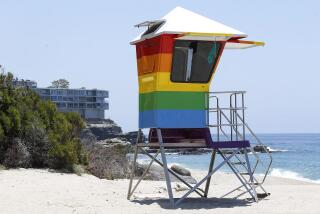Back in the Spotlight
- Share via
Brass fittings gleam from hand polishing. The smell of fresh paint gently wafts up the spiral staircase inside the tower. Crystal-clean windows offer a 360-degree view from the towering cliffs on Anacapa Island.
The historic Anacapa Lighthouse looks much as it did a generation ago when Coast Guard crews kept watch round-the-clock, filling long days on the island by scrubbing, polishing and painting.
But unlike those days when young officers kept the 85-foot tower in top shape for unannounced inspections, the Coast Guard has renovated the lighthouse for visitors to Channel Islands National Park.
“We want to open the lighthouse to public tours; we just have to work out how,” said Wayne Truax, a Coast Guard inspector who supervised the $350,000 restoration.
The National Park Service also wants to make the lighthouse a special attraction on Anacapa Island, which receives the most visitors in the five-island park because it is a mere 11 miles from Ventura County’s coastline.
Park officials have gone to great lengths to preserve the island and its heritage. Guided tours of the lighthouse, which is listed with the National Register of Historic Places, would seem to fit right in, they say.
Stepping off the boat is like stepping back through time: A small cluster of buildings is
surrounded by a huge rookery for seabirds. This time of year, squawking sea gulls sit on fat, speckled eggs. Ice plants burst with fuchsia-colored blooms.
“Physically, it looks pretty much the same,” said Jim Oliver, a retired Coast Guard officer returning for the first time since he tended lighthouse in the early 1960s.
*
Coast Guard and park officials congregated on the island Thursday for the unveiling of the 64-year-old lighthouse, which has just received its first major face-lift.
“Be careful of the surfaces; there is still some wet paint,” said Truax, leading a train of Coast Guard officials up the winding staircase.
The transformation was remarkable for those who had seen the lighthouse in the fall, when it had slipped into in a disgraceful state of disrepair.
“Oooweee,” yelled Susanne Perkins, the Coast Guard’s construction manager, staring up into the freshly painted tower. “This is amazing.”
It has been nearly three decades since the Coast Guard automated the lighthouse, eliminating the need to staff it and inadvertently robbing the structure of its daily tending. Salt spray, the wind and rain had taken their toll.
“Lighthouses are supposed to breathe,” Truax said. “If they don’t, they rot.”
*
Rot it did. Brass vents were sealed shut, turning the tower into a giant sweatbox. Condensation collected on the windows. Rust bled down the walls. Mechanical parts froze.
A team of contract workers spent a month sandblasting rust and multiple layers of lead and asbestos-laced paint from every surface.
They spent another five months rebuilding dilapidated window casings, restoring and buffing the metal cupola, replacing glass and mechanical parts hopelessly deteriorated by the elements.
Finally, they installed a new solar-powered lantern, which casts a beam 22 miles to mark the entrance of the Santa Barbara Channel. The original Fresnel lens is in a small museum nearby.
All of the work had to be completed during the rainy season, between November and April, so as to not interfere with the nesting season of the brown pelicans and least terns, two birds in danger of extinction.
The ill-tempered weather on the wind-swept island tested the mettle of the workers. The crew surrounded the lighthouse with shrink-wrapped plastic on a frame of metal scaffolding. The enclosure was engineered to withstand winds of up to 80 mph.
Four times, the wind and wind-driven rain exceeded 100 mph, ripping the protective plastic and scattering it around the island. Four times, the crews had to pick up the tattered pieces and rebuild their weatherproof cocoon.
“It took a lot of time,” said Dwennon Healy, project superintendent.
*
At one point, the Coast Guard considered bringing in a helicopter to airlift the cupola to the mainland for restoration in a controlled environment, said Judd Janes, a project architect for the Coast Guard. The idea was abandoned as unworkable, given the difficulty of a helicopter hoisting a heavy load in strong winds that buffet the island.
“The problem wasn’t so much lifting it off,” he said, “as much as putting it back.”
More to Read
Sign up for The Wild
We’ll help you find the best places to hike, bike and run, as well as the perfect silent spots for meditation and yoga.
You may occasionally receive promotional content from the Los Angeles Times.






